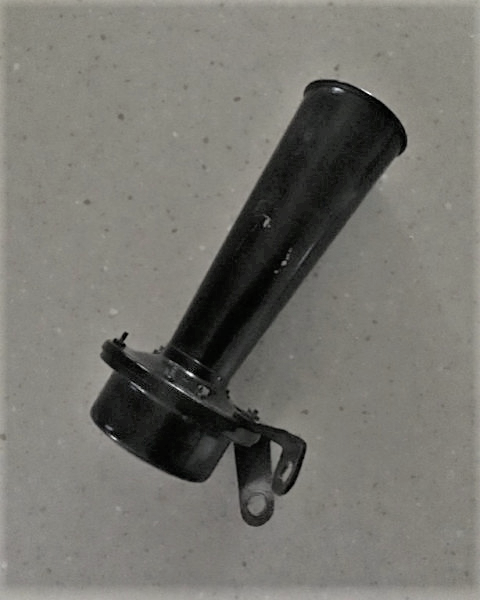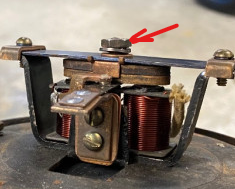Page 1 of 1
1924 6 volt horn
Posted: Mon Nov 21, 2022 3:20 pm
by Art Ebeling
Does anyone here fix or restore the 6 volt horn for a 1924 ? The 24 I am putting back together has a horn that mounts on a head stud and water inlet bolt. I have tried jumping it to a 6 volt battery but get nothing. I took it apart and it all looks good inside, no broken wires, etc. I would buy one if someone has a working one for sale, but I thought I would see if anyone repairs them before putting a WTB ad in the classifieds. Thanks, Art
Re: 1924 6 volt horn
Posted: Mon Nov 21, 2022 4:48 pm
by John kuehn
Is it a Ford horn? If it is look in the Ford service manual and there is some information in making adjustments. The set screw in the back of the diaphragm may need adjustment.
Remove the back cover and check the condition of the diaphragm. If it’s not rusted badly or rusted through it may be just a adjustment that’s needed. Replacement diaphragms are available from the parts houses if it needs replacing.
Re: 1924 6 volt horn
Posted: Mon Nov 21, 2022 5:19 pm
by Dan Haynes
If it's a magneto horn it won't work on battery current.
Re: 1924 6 volt horn
Posted: Mon Nov 21, 2022 5:35 pm
by John kuehn
That’s a good point.
Here’s a pic of the Ford battery horn.
Re: 1924 6 volt horn
Posted: Mon Nov 21, 2022 11:54 pm
by Steve Jelf
Re: 1924 6 volt horn
Posted: Mon Nov 21, 2022 11:58 pm
by TRDxB2
I lighten the image. Steve beat me with a better image

- hornnnnn.png (330.61 KiB) Viewed 3403 times
--
--
Is it stamped FORD?
--
https://www.mtfca.com/discus/messages/5 ... 19878.html
John F. Regan on Thursday, September 10, 2015 - 09:25 am:
Mag horns are wired 2 different ways. The early mag horns have both electrical connections isolated from the horn housing and thus isolated from ground. These are used on the 1915 to early 1917 or so. On those cars one connection of the mag horn is connected to the mag post of the motor and the other connection goes up the steering column to the horn button where it is grounded to complete the circuit and honk the horn. On late mag horns one of the connections is wired directly to ground internally and there is only a single outside power connection for the horn. On the later cars a wire from the magneto goes up to the horn button and then the button completes the connection to another wire that goes down the column to the horn connection. Thus the horn button supplies a "hot" power connection to the horn. The mag horn housing MUST be grounded on these horns. During the transition years the magneto horns were supplied with 2 isolated connections but one of them had to be grounded when used on later cars. This grounding of one of the connections was accomplished by simply removing the outside hardware and insulation washer and then putting the hardware back in place without the insulating washer to thus ground the connection to the horn housing. The horn then had to be mounted with a good ground to its housing.
Thus you can make an early horn (with 2 connections) work on any T with a magneto and horn button but you cannot use the later magneto horn on the early T unless you go inside of it and remove the internal ground connection and then redrill the horn and bring out the previously grounded connection so that it can be grounded by the horn button as used on 15-early 17.
....
My line on mag horns is that if you find one that sounds just AWFUL it is probably NOS.
Re: 1924 6 volt horn
Posted: Tue Nov 22, 2022 12:46 am
by Steve Jelf
I think there's a good reason you see so many 1915 Fords with aftermarket mechanical horns. 
Re: 1924 6 volt horn
Posted: Tue Nov 22, 2022 6:26 am
by Art Ebeling
This horn looks the same but says Aimes. It does not say Ford. I'm going to take it apart again and have another look. Art
Re: 1924 6 volt horn
Posted: Tue Nov 22, 2022 6:29 am
by Lil Teezy
I bet we can get you beepin again remotely. I had to remake the points set and added a capacitor to mine to reduce the arc across the points. It’s very loud now and nice and touchy at the button! The adjustment is a little trial and error but not difficult. Start with just swiping an emery board or folded sandpaper (or heck, a point file if ya got one) between the contacts in there. Doesn’t take much dust or corrosion to interrupt the circuit and the gap adjustment does not seem to be super critical. Post a photo of it’s innards and the group can determine the steps to set it up easily I’m sure. Can’t have you without your dying goose on board! To me it’s one of the most fun parts of the T experience and I find I actually need it in traffic quite frequently around here, go figure… -Chris, in Boulder
Re: 1924 6 volt horn
Posted: Tue Nov 22, 2022 8:24 am
by Art Ebeling
Here is the inside. Art
Re: 1924 6 volt horn
Posted: Tue Nov 22, 2022 10:10 am
by Lil Teezy
Looks tidy enough in there! Wonder if those points are too far gone? Make sure that the wire is still insulated completely and the fiber washers on the post are not too dirty or broken down. You want no continuity between that wire and the housing. Try to file the points down a little more evenly so they contact each other more completely. You may have to loosen the two screws holding the “lower” points “bracket” and close up the gap a smidge. Maybe I read that it wants something like .16 but I might have imagined that just now too….If you try to move the plunger, is it already bottomed out? It needs enough motion to open the points and break the circuit then return and let them close up again creating the circuit. The set screw and locking nut up on top of the springy bar do that. Diaphragm looks ok but take it out and make sure it’s not frozen up or stuck somehow. Nice work getting in there for those close ups. Unless a wire is broken somewhere out of sight thing should honk!
Re: 1924 6 volt horn
Posted: Tue Nov 22, 2022 3:53 pm
by Jerry VanOoteghem
I'd start by tightening that loose nut shown in your 1st photo.

- nut.png (82.85 KiB) Viewed 3268 times
Re: 1924 6 volt horn
Posted: Tue Nov 22, 2022 5:32 pm
by Art Ebeling
That nut was tight, I had loosened it. Are the points supposed to be open or closed with no voltage applied? I put voltage to this and get nothing. Thanks, Art
Re: 1924 6 volt horn
Posted: Tue Nov 22, 2022 5:56 pm
by Jerry VanOoteghem
The points should be closed with no voltage applied.
Can you check for continuity in the coils?
Re: 1924 6 volt horn
Posted: Tue Nov 22, 2022 7:59 pm
by John kuehn
Here’s a question? Did Ford use Ames horns or were they an aftermarket or used on a similar car. Just wondering!
Re: 1924 6 volt horn
Posted: Tue Nov 22, 2022 10:35 pm
by Jim, Sr.
John kuehn wrote: ↑Tue Nov 22, 2022 7:59 pm
Here’s a question? Did Ford use Ames horns or were they an aftermarket or used on a similar car. Just wondering!
Even though Ford Model T's could have the starter, generator, and battery in the electrical system, starting with the 1919 models, they did not start putting battery horns in Model T's until sometime in 1922. The battery horn replaced the magneto horn on the cars that had the battery electrical system. Otherwise,they continued with magneto horns to 1927. The first battery horns were supplied by Ames. The Ames horn has a shorter cone than the Ford horn, but looks very much the same, and uses the same mounting bracket. I do not know how long it was before Ford started making their own horn, but I think I think it was before the 1923 models came out.
John Regan did the research on these horns and knows all the details.
I have a 1922 Model T coupe that was produced on August 16, 1922. It has an Ames horn. I really think it is much louder than the Ford horns. It puts out a good loud blast.